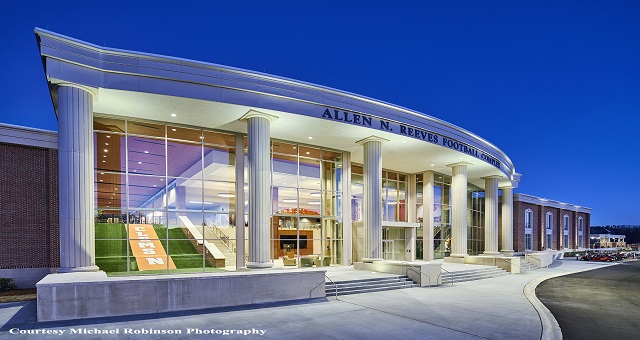Too often, when educational facilities look to add unique or architecturally impactful buildings on campus, restrictive fire codes put a damper on designs or threaten to significantly increase costs and compromise functionality.
However, Clemson University, which recently constructed a new state-of-the-art home for its 2016 NCAA championship football team, was able to rethink conventional wisdom with a radical, more flexible approach to fire code interpretations.
The Allen N. Reeves Football Complex is the first in South Carolina history to utilize a performance-based design code analysis approach (tested to meet specific goals) to fire code safety, instead of a traditional prescriptive approach (adhering strictly to written codes), according to Paul Borick, one of Clemson University’s Capital Projects, project managers for renovations and new construction.
“Universities have so many uniquely shaped or large volume spaces – like sports centers, pools, weight rooms, aerobic rooms, as well as classrooms and labs pushed up against multi-story structures and assembly areas – that don’t quite fit the prescriptive fire code,” says Borick.
Performance Based Design
As an International Code Council (ICC) accepted alternative, performance based design allows “alternate materials and methods” that offer equivalent or superior fire safety performance. With this approach, a design is considered acceptable if the fire engineering calculations demonstrate that it meets the measurable performance criteria set at the start of the process.
In Clemson’s case, to consolidate operations the university sought to construct the 142,500 sq. ft. Allen N. Reeves Football Complex adjacent to its existing indoor football practice facility and outdoor practice fields.
The state-of-the-art building, designed by architecture and firms Goodwyn Mills and Cawood, Inc. (GMC) and HOK, along with MEP engineering services from RMF Engineering, adjoins the indoor practice facility and outdoor practice fields, consolidating football operations into one complex.
“We wanted to put a new two-story football complex building next to our indoor practice facility, but the prescriptive code made this difficult,” says Borick.
“The challenge was that if we attached the two buildings, the prescriptive code would have required us to separate the buildings by 60 feet or create a firewall between them, as well as fireproof all the existing structural steel in our big, open 100,000 square foot facility,” says Borick. “This would have cost well over $1 million, so we had to find an alternative.”
Clemson University turned to Jensen Hughes Inc., one of world’s the largest fire protection and life safety engineering and consulting firms.
“The way the building was configured, it did not fit into the prescriptive requirement box,” says Mike Ernst, Senior Fire Protection Engineer at Jensen Hughes. “So we looked at the intent of the prescriptive code requirements.”
By adopting a performance-based design approach, computer egress modeling software, and an innovative smoke detection technology, the university was able to dramatically reduce the project cost while increasing safety.
In a performance based design approach one of the ways to meet safety code requirements is to utilize egress modeling. “Jensen Hughes staff filmed how our football players exited their main team room and moved together before entering their individual position meeting rooms,” says Borick. “They analyzed the video to determine how their exit could be expedited and restrictions removed.”
Along with this, Clemson University utilized advanced smoke detection technology in the form of four VESDA-E VEA fire alarm system units, manufactured by Xtralis, a global provider of early detection and remote visual verification of fire, gas and perimeter threats.
“For the VEA your detection time is essentially zero,” says Ernst. “Overall, we gained 2-3 minutes of time to egress for each scenario due to early detection [compared to standard detection].”
Aspirating Technology
In smoke detection, advanced technologies provide earlier warning by aspirating – or drawing in air – from each room through small, flexible tubing. The air is then analyzed to identify the presence of minute smoke particles in a continuous process.
“The VEA allowed us to get earlier warning to the occupants, which allowed them to move earlier and fully egress the building in less time than the prescriptive alarm initiation requirements,” says Ernst.
“By going to a performance based design and [aspirating technology], egress is faster and the building safer than if we followed prescriptive code,” agrees Borick. “The VEA system provides earlier, more intelligent alerts so the fire department can act quickly.
For university administrators overseeing any type of building, addition, or renovation that does not quite fit the prescriptive code, Borick recommends considering the use of a performance-based code provision.
“The ultimate goal in any collegiate environment is safety, getting people out of the building quickly in case of a fire,” concludes Borick. “In that regard, by following performance based design, I think we have created a much safer environment for our student athletes in this new facility than if we followed the prescriptive code. While our project may be the first to use this design method in South Carolina, I soon expect a slew of such projects may also consider this method on campuses nationwide.”
Article contributed by Xtralis, 175 Bodwell Street, Avon, MA 02322; www.xtralis.com/vea.



